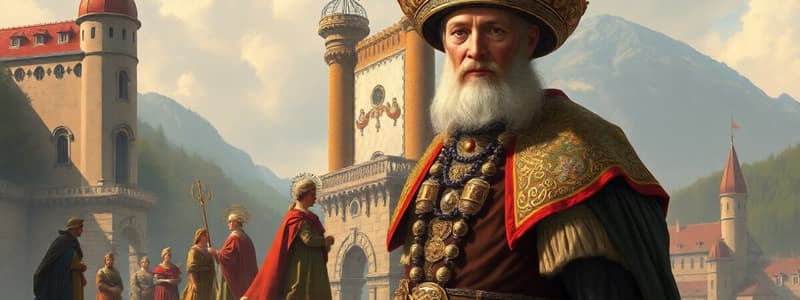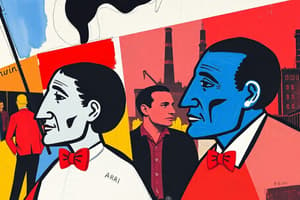Podcast
Questions and Answers
What characterized the political structure of mid-eighteenth-century Europe?
What characterized the political structure of mid-eighteenth-century Europe?
- Nation-states with centralized governments
- Autonomous territories divided into various regions (correct)
- A unified European federation
- A single democratic regime across Europe
Which of the following regions was NOT part of the Habsburg Empire?
Which of the following regions was NOT part of the Habsburg Empire?
- Bohemia
- Hungary
- Scotland (correct)
- Tyrol
What was a common factor among the diverse peoples within the Habsburg Empire?
What was a common factor among the diverse peoples within the Habsburg Empire?
- Common political objectives
- Shared religious beliefs
- Allegiance to the emperor (correct)
- Unified languages
Which of these regions had a predominantly Hungarian-speaking population?
Which of these regions had a predominantly Hungarian-speaking population?
What hindered the development of political unity in mid-eighteenth-century Europe?
What hindered the development of political unity in mid-eighteenth-century Europe?
Which group was part of the aristocracy in Bohemia?
Which group was part of the aristocracy in Bohemia?
Flashcards
Fragmented Europe
Fragmented Europe
In the mid-18th century, Europe was not organized into the nation-states we know today. Instead, regions like Germany, Italy, and Switzerland were divided into smaller independent kingdoms, duchies, and cantons, each ruled by their own leader.
Diversity in Europe
Diversity in Europe
Different groups of people within these regions didn't share a common identity or culture. They spoke different languages and had distinct ethnicities.
Habsburg Empire's Diversity
Habsburg Empire's Diversity
The Habsburg Empire was a great example of this diversity, encompassing many different regions and peoples, each with its own unique characteristics.
Obstacles to Political Unity
Obstacles to Political Unity
Signup and view all the flashcards
Allegiance to the Emperor
Allegiance to the Emperor
Signup and view all the flashcards
Study Notes
Mid-Eighteenth Century Europe
- Mid-18th century Europe lacked modern nation-states
- Germany, Italy, and Switzerland were divided into kingdoms, duchies, and cantons with autonomous territories
- Eastern and Central Europe had autocratic monarchies over diverse populations
- These populations often lacked collective identity or a common culture
- Different ethnic groups spoke different languages
- The Habsburg Empire (Austria-Hungary) was a diverse region
- Included the Tyrol, Austria, Sudetenland, Bohemia (German-speaking aristocracy)
- Lombardy and Venetia (Italian-speaking provinces)
- Hungary (Magyar speakers, other dialects)
- Galicia (Polish-speaking aristocracy)
- Other groups within the empire included Bohemians, Slovaks, Slovenes, Croats, and Romanians
- Diversity of language and ethnicity hindered political unity
- Common allegiance to the emperor was the only tie unifying these diverse groups
Studying That Suits You
Use AI to generate personalized quizzes and flashcards to suit your learning preferences.




